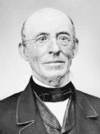
Garrison, William Lloyd
(born December 10/12, 1805, Newburyport, Massachusetts, U.S.—died May 24, 1879, New York, New York) American journalistic crusader who published a newspaper, The Liberator (1831–65), and helped lead the successful abolitionist campaign against slavery in the United States.
Garrison was the son of an itinerant seaman who subsequently deserted his family. The son grew up in an atmosphere of declining New England Federalism and lively Christian benevolence—twin sources of the abolition movement, which he joined at age 25. As editor of the National Philanthropist (Boston) in 1828 and the Journal of the Times (Bennington, Vermont) in 1828–29, he served his apprenticeship in the moral reform cause. In 1829, with a pioneer abolitionist, Benjamin Lundy, he became co-editor of the Genius of Universal Emancipation in Baltimore; he also served a short term in jail for libeling a Newburyport merchant who was engaged in the coastal slave trade. Released in June 1830, Garrison returned to Boston and, a year later, established The Liberator, which became known as the most uncompromising of American antislavery journals. In the first issue of The Liberator he stated his views on slavery vehemently: “I do not wish to think, or speak, or write, with moderation . . . . I am in earnest—I will not equivocate—I will not excuse—I will not retreat a single inch—AND I WILL BE HEARD.”
Like most of the abolitionists he recruited, Garrison was a convert from the American Colonization Society, which advocated the return of free blacks to Africa, to the principle of “immediate emancipation,” borrowed from English abolitionists. “Immediatism,” however variously it was interpreted by American reformers, condemned slavery as a national sin, called for emancipation at the earliest possible moment, and proposed schemes for incorporating the freedmen into American society. Through The Liberator, which circulated widely both in England and the United States, Garrison soon achieved recognition as the most radical of American antislavery advocates. In 1832 he founded the New England Anti-Slavery Society, the first immediatist society in the country, and in 1833 he helped organize the American Anti-Slavery Society, writing its Declaration of Sentiments and serving as its first corresponding secretary. It was primarily as an editorialist, however, excoriating slave owners and their moderate opponents alike, that he became known and feared. “If those who deserve the lash feel it and wince at it,” he wrote in explaining his refusal to alter his harsh tone, “I shall be assured that I am striking the right persons in the right place.”
In 1837, in the wake of financial panic and the failure of abolitionist campaigns to gain support in the North, Garrison renounced church and state and embraced doctrines of Christian “perfectionism,” which combined abolition, women's rights, and nonresistance, in the biblical injunction to “come out” from a corrupt society by refusing to obey its laws and support its institutions. From this blend of pacifism and anarchism came the Garrisonian principle of “No Union With Slaveholders,” formulated in 1844 as a demand for peaceful Northern secession from a slaveholding South.
By 1840 Garrison's increasingly personal definition of the slavery problem had precipitated a crisis within the American Anti-Slavery Society, a majority of whose members disapproved of both the participation of women and Garrison's no-government theories. Dissension reached a climax in 1840, when the Garrisonians voted a series of resolutions admitting women and thus forced their conservative opponents to secede and form the rival American and Foreign Anti-Slavery Society. Later that year a group of politically minded abolitionists also deserted Garrison's standard and founded the Liberty Party. Thus, 1840 witnessed the disruption of the national organization and left Garrison in control of a relative handful of followers loyal to his “come-outer” doctrine but deprived of the support of new antislavery converts and of the Northern reform community at large.
In the two decades between the schism of 1840 and the Civil War, Garrison's influence waned as his radicalism increased. The decade before the war saw his opposition to slavery and to the federal government reach its peak: The Liberator denounced the Compromise of 1850, condemned the Kansas-Nebraska Act, damned the Dred Scott decision, and hailed John Brown's raid as “God's method of dealing retribution upon the head of the tyrant.” In 1854 Garrison publicly burned a copy of the Constitution at an abolitionist rally in Framingham, Massachusetts. Three years later he held an abortive secessionist convention in Worcester, Massachusetts.
The Civil War forced Garrison to choose between his pacifist beliefs and emancipation. Placing freedom for the slave foremost, he supported Abraham Lincoln faithfully and in 1863 welcomed the Emancipation Proclamation as the fulfillment of all his hopes. Emancipation brought to the surface the latent conservatism in his program for the freedmen, whose political rights he was not prepared to guarantee immediately. In 1865 he attempted without success to dissolve the American Anti-Slavery Society and then resigned. In December 1865 he published the last issue of The Liberator and announced that “my vocation as an abolitionist is ended.” He spent his last 14 years in retirement from public affairs, regularly supporting the Republican Party and continuing to champion temperance, women's rights, pacifism, and free trade. “It is enough for me,” he explained in justifying his refusal to participate in radical egalitarian politics, “that every yoke is broken, and every bondman set free.”
Copyright © 1994-2005 Encyclopædia Britannica, Inc.

